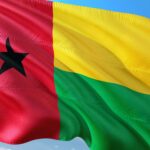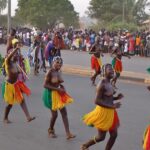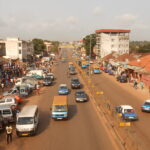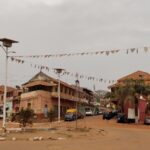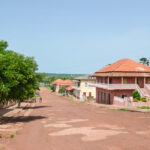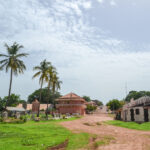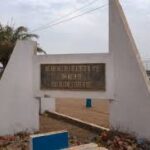Translate
The ultimate guide to solo travel in Bissau, Guinea Bissau
About Guinea Bissau
Africa is a continent often overlooked as a possible tourist destination. West African countries, in particular, have hugely impacted the continent. From cuisines, music to clothing, and much more and Senegal is no exception.
Guinea-Bissau is situated on the western coast of Africa. Its neighbouring countries are Guinea and Senegal. The capital city is Bissau. Guinea Bissau is a relatively small Portuguese speaking country in West Africa that is often overlooked as a tourist attraction.
But with so many rivers and amazing coastlines and islands, the country is home to some great beaches and carnivals.
A little, due to political instability. In the country, the streets do feel a little tense and military presence can be seen. The capital, Bissau does however have a very pleasant village feel to it which I quite enjoyed and felt safe in. Alongside this, the country is full of incredibly friendly and helpful people who make your experience in the country 100 times better.
Though no country is 100% safe, it’s best practice to always walk with a purpose (don’t look like a tourist or lost), If you are lost always go into a shop to ask for directions rather than strangers on the street. As a solo female traveller you should also be mindful of your things, whether that’s your bag at a restaurant or drinks at a bar, never leave your things unattended.
Accommodation will be your biggest expense in Bissau as Guinea Bissau doesn’t get many tourists. Many who stay in hotels are diplomats or government officials and therefore prices for below basic accommodation can often be extortionate. I was paying around £79 a night for a very very basic hotel room in the old town with hotel.com and this was the cheapest hotel! I’m not too sure if other services such as Airbnb are available even in the capital so in rural areas this would be virtually non-existent.
As I went to Bissau during carnival season hotels on Varela island were really expensive so be mindful of this if you plan to see the country’s festival to book your hotel far in advance
Backpacking is something I doubt exists in the country, unfortunately.
Though Guinea Bissau doesn’t receive a lot of tourists, this country does hols some charming places to visit. In the capital, Bissau, some of these include;
Old city
This neighbourhood is still in the capital, Bissau but is now a cultural hub with many colonial-style houses still erect. It’s well worth a visit when in the capital as it does feel like you’re stepping back into time.
The IBAP Nature Reserve
This nature reserve is not only a great place to go if you love nature but is an amazing place to learn about the culture of Bissau- Guineans. The compound also has a library detailing the country’s natural flora and fauna
Fortaleza de São José da Amura
This fortress is a former Portuguese headquarters and now serves as a museum in the country. With stone made walls standing high and trees covering the fortress, it’s an eerie drive up there but once in, you’re able to learn a lot about Guinea Bissau’s culture and history.
Igreja Católica/ Bissau Cathedral
This Cathedral is located in the old city and is surrounded by beautiful greenery. It’s definitely a must-see in the city as its architecture is beautiful inside and out.
Parque Lagoa N’Batonha
This park is the perfect place to relax and unwind after a long day as it’s an incredibly peaceful and quiet spot away from the busy city. With diverse plant and bird species, It’s a perfect place for bird watchers.
Island hop
If the city life gets a little too much for you, island hopping to some of the close islands to the Capital. The collection of around 88 small islands are called Bissagos Islands. As I have only been to Varela, I can’t comment as to which island is best to go to, but locals can definitely help you on that front! These islands are definitely worth a visit as they are remote, calm and peaceful with great beaches too.
Enjoy the festival
Though I didn’t personally get to see the festival, all who’ve been have told me amazing things about this festival. Held around February/March time and located on all the Bijagos islands. The four-day Carnival is celebrated by different ethnic groups and inhabitants of the small villages and other towns of the country come together to present their culture and traditions. The first day of the Carnival of Guinea-Bissau is dedicated to the opening of the event showcasing the traditional and contemporary masks made by different ethnic groups. Most of these masks were for the occasion out of coloured paper-mâché. The warriors wear crocodile-skin suits and parade waving arrows in the distance. This opening parade continues for hours in the streets
The following days are devoted to parading floats, dance performances and traditional music concerts. Though I’ve been told that Varela carnival is best, I definitely have to go back again another year to see for myself.
This is definitely the place to be for party lovers during festival time and for beach holidays all year round as it has some of the country’s best beaches.
Visit Poilao
This beautiful uninhabited island, not only has a beach by lush greenery and is home to some beautiful wildlife. The beach too is nothing short of beautiful, here various species of turtles can be seen.
Visit the old colonial town of Bafata
Bolama was actually the Portuguese capital of Guinea-Bissau from 1879 to 1943, which are awash with crumbling relics that were abandoned after independence. It is the closest island to the mainland with a huge colonial presence running through it. Here buildings, streets and local cuisine are indicative of the historic past. The town of Bafata is one steeped into Guinea Bissau history. This is an old colonial town and is the capital of Bafatá Region in Guinea-Bissau. It was the birthplace of Amílcar Cabral, poet and one of Africa’s foremost anti-colonial leaders. The town has some preserved colonial buildings such as the Bafata Cathedral, the colonial centre and the old market.
Presidential palace guinea Bissau
The Presidential Palace is situated in the capital city of Bissau. At its height, it was one of the most substantial buildings in the city. It was partially damaged by the civil war however I do believe this adds to its architectural mystique and history.
Monumento aos Heróis da Independência
This historical landmark is a monument of Guinea Bissau’s history and is located in the heart of the city. The monument has vast space around it so it’s not uncommon to see children playing here alongside many locals who like to go play sports, relax and be free
During the country’s dry season which fortunately lasts half the entire year between the months of November to April. March and April would probably be the best months within this season as The weather temperatures are quite warm without too much humidity and relatively cool weathers at night.
- Learn basic Portuguese. As this country is a former Portuguese colony without many tourists, the majority of people speak English with virtually no one speaking English and very few speaking French. Speaking Portuguese will help you navigate around the country.
- Get Cash! There are few ATMs in the capital Bissau and even fewer in rural areas so it’s always best to carry some West African franc on you
- Get a sim
If you plan to stay in the country for a long time, it may be useful for you to get a sim card, these can easily be bought in phone shops. Public WiFi is not really common. Though some upscale restaurants do have WiFi, it may be safer as a solo female traveller to stay connected on your go throughout the city too.
Meeting locals won’t be hard here as everyone is very warm and friendly. I found that the best way to meet people and practice my Portuguese was by going to public places such as the beach or the Parque Lagoa N’Batonha as people were very receptive to the conversation. However, I do realise that this option may not be up to everyone’s street. Another option may be Online forums. Using sites like Facebook and joining groups is a great way to get the ball rolling, meet locals and see their city.
As I crossed the boarder via a shared car, I don’t know the quality of the airport and how easily navigating around the airport is. The main international airport is Osvaldo Vieira International Airport (OXB). This is the main and only international airport. Bubaque Airport is the second biggest airport (BQE)
A few days is more than enough to see the capital and even island-hop to some beach islands off the coast of the capital Bissau.
Unfortunately, Bissau doesn’t have as many tourist attractions as other African countries but the people really make the country shine with their warmth and welcoming presence.
If you are going for a carnival, you may need more time to recover from the late nights partying.
Can I drink the water? No
Is tipping expected? No
Fixed price or barter? Haggling should be second nature here in areas such as markets
Any ATMs? Yes, but there are very few in the city centre and even less in rural areas.
Which side of the road do they drive? Right
Good for vegetarians? Unfortunately no, Like many west African countries, fish and meat is a big part of Bissau – Guinean diets.
Any seven wonders of the world? No
Plan a trip to Guinea Bissau
If you are ready to solo travel Guinea Bissau here are some useful links to help you plan your travel.
Facts
Budget – (£5 – £15 daily minus accommodation)
Capital – Bissau
Population – 1.9 million
Language spoken – Portuguese
Local Currency – West African Franc (CFA)
Do I need a visa? – No for ECOWAS passport holders, yes for British citizens. As there is no Guinea Bissau Embassy in England you will need to contact the embassy in Paris about Visa arrangements.
Flying time to Bissau – 10 hours
Did you know? People from Guinea-Bissau are called Bissau Guineans.
Follow Us
Want more guides?
Have a story? Would you like to be a writer for our platform? If so, Contact us below
Weekly Blog Stats
- 25,131 Views

